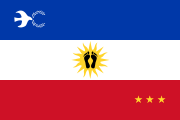Pieds-noirs
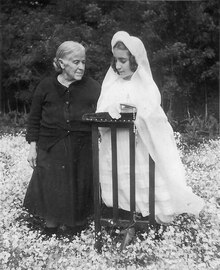 AFirst Communionin apied-noirfamily inSidi-Bel-Abbès,Colonial Algeria in the early 20th century | |
| Total population | |
|---|---|
| 1959: 1.4 million[1](13% of the population of Algeria) | |
| Regions with significant populations | |
| Algiers,Oran,Constantine | |
| Languages | |
| French,Spanish,Catalan,Occitan,Maghrebi Arabic | |
| Religion | |
| Predominantly:ChristianityMinority:Judaism |
Thepieds-noirs(French:[pjenwaʁ];lit. 'black feet';sg.:pied-noir) are an ethno-cultural group of people ofFrenchand otherEuropean descentwho were born inAlgeriaduring theperiod of French rulefrom 1830 to 1962. Many of them departed formainland Franceduring and after the war by which Algeria gained its independence in 1962.[3][4]
From theFrench invasionon 18 June 1830 to its independence, Algeria was administratively part of France; its ethnic European population were simply called Algerians orcolons(colonists). But the Muslim people of Algeria were calledArabs,Muslimsorindigènes.The termpied-noircame into common use shortly before the end of theAlgerian Warin 1962.
As of the last census in French-ruled Algeria, taken on 1 June 1960, there were 1,050,000 non-Muslim civilians, some 10 per cent of the population.[5]Mostpieds-noirswereCatholicand of European descent, but their population included around 130,000 indigenousAlgerian Jewswho were granted French citizenship through theCrémieux Decreeand were viewed as a part of thepieds-noirscommunity.[6][5]
During the Algerian War, a vast majority ofpieds-noirswere loyalists and overwhelmingly supported colonial French rule in Algeria. They were opposed to Algerian nationalist groups such as theFront de libération nationale(English: National Liberation Front) (FLN) andMouvement national algérien(English: Algerian National Movement) (MNA). The roots of the conflict lay in political and economic inequalities perceived as an "alienation" from the French rule as well as a demand for a leading position for theBerber,ArabandIslamiccultures and rules existing before the French conquest. The conflict contributed to the fall of theFrench Fourth Republicand the exodus of European and Jewish Algerians to France.[4][7]
After Algeria became independent in 1962, about 800,000pieds-noirsof French nationality evacuated to mainland France, while about 200,000 remained in Algeria. Of the latter, there were still about 100,000 in 1965, about 50,000 by the end of the 1960s and 30,000 in 1993.[8]During theAlgerian Civil Warbetween 1992 and 2002, the population ofpieds-noirsand others of European descent plummeted, as they were often targeted byIslamistrebel groups. The French Consulate in Algiers recorded that around 300 persons of European descent remain in the country, whereas an Algerian census company recorded the number as higher.[9]Thepieds-noirswho have remained since independence are now overwhelmingly elderly.[10]
Those who moved to France suffered ostracism from someleft-wingpolitical movements for their perceived exploitation of native Muslims, while others blamed them for the war and thus for the political turmoil surrounding the collapse of the Fourth Republic.[4]In popular culture, the community is often represented as feeling removed fromFrench culturewhile longing for Algeria.[4][7]The recent history of thepieds-noirshas been characterized by a sense of twofold alienation, on the one hand from the land of their birth and on the other from their adopted homeland. Though the termrapatriés d'Algérieimplies that prior to Algeria they once lived in France, mostpieds-noirswere born and raised in Algeria.
Etymology
[edit]
There are competing theories about the origin of the termpied-noir.According to theOxford English Dictionary,it refers to "a person of European origin living in Algeria during the period of French rule, especially a French person expatriated after Algeria was granted independence in 1962".[3]TheLe Robertdictionary states that in 1901 the word indicated a sailor working barefoot in the coal room of a ship, who would find his feet blackened by the soot and dust. Since in the Mediterranean this was often an Algerian native, the term was used pejoratively for Algerians until 1955, when it first began referring to "French born in Algeria" according to some sources.[11][12]TheOxford English Dictionaryclaims this usage originated from mainland French as a negative nickname.[3]

There is also a theory that the term comes from the black boots worn by French soldiers compared to the barefoot Algerians.[13]Other theories focus on new settlers dirtying their clothing by working in swampy areas, wearing black boots when on horseback, or trampling grapes to make wine.[14]
History
[edit]French, along with Spanish, Italian and other European settlers, moved to France's overseas colonies or territories. The largest group of one million settled in Algeria, followed by 200,000 in Morocco and proportionally fewer in other colonies. These settlers often took land that had been forcibly taken from the local population. While they had full political representation in Paris and the French government, the native population did not. Many settlers were fiercely committed to maintaining the overseas empire because they came from impoverished European backgrounds. Nearly half of the Algerian settlers in the 1880s were from Spain, southern Italy, or Malta, and the remainder were mostly poor French. They had nothing to return to if a local nationalist movement won its war of national liberation.[15]
French conquest and settlement
[edit]


European settlement of Algeria began during the 1830s, after France had commenced the process of conquest with the military seizure of the city of Algiers in 1830. The invasion was instigated when theDey of Algiersstruck the French consul with a fly-swatter in 1827, although economic reasons are also cited. In 1830 the government ofKing Charles Xblockaded Algeria and anarmadasailed to Algiers, followed by a land expedition. A troop of 34,000 soldiers landed on 18 June 1830, atSidi Ferruch,27 kilometres (17 mi) west of Algiers. Following a three-week campaign, theHussein Deycapitulated on 5 July 1830 and was exiled.[16][17][18]
In the 1830s the French controlled only the northern part of the country.[17]Entering theOranregion, they faced resistance fromEmir Abd al-Kader,a leader of aSufiBrotherhood.[19][20]In 1839 Abd al-Kader began a seven-year war by declaringjihadagainst the French. The French signed two peace treaties with Al-Kader, but they were broken because of a miscommunication between the military and the government in Paris. In response to the breaking of the second treaty, Abd al-Kader drove the French to the coast. In response, a French force of nearly 100,000 troops marched to the Algerian countryside and forced Abd al-Kader's surrender in 1847.[19]
In 1848 Algeria was divided into threedepartments(Alger,OranandConstantine), thus becoming part of France.[18][19]
The French modeled their colonial system on their predecessors, theOttomans,by co-opting local tribes. In 1843 the colonists began supervising throughbureaux arabes[16][21]operated by military officials with authority over particular domains.[21]
This system lasted until the 1880s and the rise of theFrench Third Republic,when colonisation intensified.[5]Large-scale regrouping of lands began when land-speculation companies took advantage of government policy that allowed massive sales of native property. By the 20th century Europeans held 1,700,000 hectares; by 1940, 2,700,000 hectares, about 35 to 40 percent;[16]and by 1962 it was 2,726,700 hectares representing 27 percent of the arable land[clarification needed]of Algeria.[22]Settlers came from all over the western Mediterranean region, particularlyItaly,France,SpainandMalta.[4]
Identity
[edit]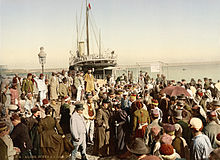
In Metropolitan France, Algeria was considered an integral part of French national territory, and this sentiment was largely shared by thepied-noircommunity.
The end of theFrench protectorate of Tunisiaand of theFrench protectorate in Moroccoin 1956 led to mass emigration of French people from both states. These two countries had been placed under protectorate, whereas Algeria and its population fell under territory status and were considered part of overseas France.
After the French committed the Sétif and Guelma massacres (1945), with the French navy and air force shelling and bombing Algerian territory, Algerians increasingly began to look towards increased autonomy or outright independence. The French government and military reacted with implementing a brutal torture regime inspired by the likes of French general Massu. The French aligned OAS started to increase murders and bombings against Algerians and French who opposed further French control of Algeria. Staying remarkably patient despite the increasing terrorism from French settlers and army, in 1954 theFLNlaunched its first operations to defend Algerians and this marks the start of theAlgerian warin 1954,Pierre Mendès France,President of the Council, addressing the French National Assembly expressed the distinction between the political status of Algeria compared to Tunisia and Morocco:[23][24][25][26]
We do not compromise when it comes to defending the internal peace of the nation, the unity, the integrity of the Republic. The departments of Algeria constitute a part of the French Republic. They have been French for a long time and irrevocably. Their populations, who enjoy French citizenship and are represented in Parliament, have moreover given in peace, as before in war, enough proof of their attachment to France for France, in its turn, not to allow in question this unit. Between them and the metropolis, there is no conceivable secession. Never France, no government, no French Parliament, whatever their particular tendencies, will ever yield on this fundamental principle. I affirm that no comparison with Tunisia or Morocco is more false, more dangerous. Here it is France. "
As the colony of Algeria grew with each generation,pieds-noirsbegan to define themselves as distinct from the French citizens of metropolitan France; they identified as Algerian people. Somepieds-noirsconsidered themselves at one time to be "true Algerians", whereas they termed Muslim Algerians as "Indigenous" peoples. An exchange between apied-noirstudent from Algiers and a metropolitan French student was recorded during aUNEFconference in 1922:[27]
"So you're Algerian… but the son of a Frenchman, aren't you?"
"Of course! All Algerians are sons of the French, the others are natives."
However, manypieds-noirsavoided using the term after the Second World War so as not to be confused with indigenous Algerian migrant workers who went to France. Thepieds-noirsthemselves also used several nicknames to designate the French in metropolitan France, such asFrench from France,Frangaoui,Patosand sometimespied-blanc(lit. 'white feet').[28]
Other terms used internally within thepied-noirpopulation includedpied-rouge(lit. 'red feet') to refer topied-noirmembers of theAlgerian Communist Partyor those who held left-wing beliefs, including a minority ofpieds-noirssympathetic to the independence movement.[29][30]The termPied-Griswas used to refer both to children with parentage from both metropolitan France and French Algeria, and to French settlers from independent Tunisia and Morocco who moved to French Algeria in the late 1950s rather than to France. French writer René Domergue noted thatPied-Griswas used by both French settlers from Tunisia and Morocco and thepieds-noirsthemselves to distinguish themselves from each other.[31]
Culture, food and language
[edit]French writer Léon Isnard noted thatpieds-noirsoften mixed traditional French and occasionally Spanish and Italian cuisine with local Arab and Jewish influences. Dishes such asgazpacho,paella,méchouiandbrochetteskewered meat were commonly consumed by thepied-noirpopulation and often accompanied withwhite wineproduced bypied-noirfarmers inTlemcenandred winefromMascara.[32]
Although French was the main language of thepieds-noirs,a distinct form of French known aspataouètedeveloped in thepied-noircommunity in Algeria and contained words, idioms, expressions and slang terms not commonly found in Metropolitan France.[33]Ferdinand Duchene noted thatpataouètewas largely derived from mainland French but contained words fromSpanishandCatalan(influenced by Spanish workers in Algerian during the late 1800s), as well asItalian,and local Arab dialect.[34]
Social structure
[edit]Like other white populations in colonial-era Africa, thepieds-noirsgenerally dominated much of Algeria's industrial, cultural and political institutions, comprising the most influential section of society. However, French Algeria also attracted laborers, blue collar and agricultural workers from metropolitan France, Spain, Italy and Malta in search of better economic opportunities. European manual laborers came under thepied-noirfold and acquired French nationality after several years of living in Algeria. As such, thepied-noircommunity contained different social classes and structures. Following the exodus to France in the aftermath of the Algerian war, working-classpieds-noirswere particularly scathing in response to accusations from the French political left that they were exploiters or elite colonialists over the indigenous population.[35][36]
Relationship to mainland France and Muslim Algeria
[edit]
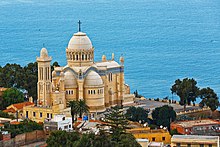
Thepied-noirrelationship with France and Algeria was marked by alienation. The settlers considered themselves French,[37]but many of thepieds-noirshad a tenuous connection to mainland France; 28 percent of them had never visited there. The settlers encompassed a range ofsocioeconomicstrata,ranging from peasants to large landowners, the latter of whom were referred to asgrands colons.[37][38]
In Algeria, the Muslims were not considered French and did not share the same political or economic benefits of the territory.[37]For example, the indigenous population did not own most of the settlements, farms, or businesses, although they numbered nearly nine million (versus roughly one millionpieds-noirs) at independence. Politically, the Muslim Algerians had no representation in theFrench National Assemblyuntil 1945 and wielded limited influence in local governance.[39]To obtain citizenship, they were required to renounce their Muslim identity – with only about 2,500 Muslims acquiring citizenship before 1930.[38][39]The settlers' politically and economically dominant position worsened relations between the two groups.
Thepied-noirpopulation as part of the total Algerian population
[edit]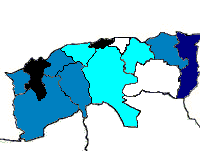
From roughly the last half of the 19th century until independence, thepieds-noirsaccounted for approximately 10% of the total Algerian population. Although they constituted a numerical minority, they were undoubtedly the prime political and economic force of the region.[citation needed]

In 1959, thepieds-noirsnumbered 1,025,000, and accounted for 10.4% of the total population of Algeria, a percentage gradually diminishing since the peak of 15.2% in 1926. However, some areas of Algeria had high concentrations ofpieds-noirs,such as the regions of Bône (nowAnnaba), Algiers, and above all the area fromOrantoSidi-Bel-Abbès.[40]Oran had been under European rule since the 16th century (1509); the population in the Oran metropolitan area was 49.3% European in 1959.

In the Algiers metropolitan area, Europeans accounted for 35.7% of the population. In the metropolitan area of Bône, they accounted for 40.5% of the population. Thedépartementof Oran, a rich European-developed agricultural land of 16,520 km2(6,378 sq. miles) stretching between the cities of Oran and Sidi-Bel-Abbès, and including them, was the area of highestpied-noirdensity outside of the cities, with thepieds-noirsaccounting for 33.6% of the population of thedépartementin 1959.
| Year | Algerian Population | Pied-noirpopulation |
|---|---|---|
| 1830 | 1,500,000 | 14,000 (in1836) |
| 1851 | 2,554,100 | 100,000 (in1847) |
| 1960 | 10,853,000 | 1,111,000 (in1959) |
| 1965 | 11,923,000 | 100,000 (in1965) |
Jewish community
[edit]
Jewswere present in North Africa and Iberia for centuries, some since the time when "Phoenicians and Hebrews, engaged in maritime commerce, foundedHippo Regius(current Annaba),Tipasa,Caesarea (currentCherchel), and Icosium (current Algiers) ".[45]According to oral tradition they arrived fromJudeaafter theFirst Jewish–Roman War(66–73 AD). It is known historically that manySephardi Jewscame following the SpanishReconquista.[6]Others came after Spain expelled Jews in 1492.
In 1870, Justice MinisterAdolphe Crémieuxwrote a proposal,décret Crémieux,to give French citizenship to most Algerian Jews. This advancement was resisted by part of the largerpied-noircommunity and in 1897 a wave of anti-Semitic riots occurred in Algeria. During World War II thedécret Crémieuxwas abolished under theVichyregime. Jews were barred from professional jobs between 1940 and 1943.[45]Citizenship was restored in 1943, after theFree Frenchtook control over Algeria in the wake ofOperation Torch.Thus, the Jews of Algeria eventually came to be considered part of thepied-noircommunity.[6]Many fled the country to France in 1962, alongside most otherpieds-noirs,after the Algerian War.[46]
Mozabite Jewswere excluded from theCrémieux Decree,and were only granted “common law civil status” and French citizenship in 1961.[47]
Algerian War and exodus
[edit]Algerian War
[edit]For more than a century France maintainedcolonial rulein Algerian territory. This allowed exceptions to republican law, includingSharialaws applied by Islamic customary courts to Muslim women, which gave women certain rights to property and inheritance that they did not have under French law.[45]Discontent among the Muslim Algerians grew after the World Wars, in which the Algerians sustained many casualties.[45]Algerian nationalists began efforts aimed at furthering equality by listing complaints in theManifesto of the Algerian People,which requested equal representation under the state and access to citizenship, but no equality for all citizens to preserve Islamic precepts. The French response was to grant citizenship to 60,000 "meritorious" Muslims.[17]
During a reform effort in 1947, the French laws were changed to give the former French subjects with the legal status of "indigenes" full French legal citizenship. The French created an Algerian Assembly, a form ofbicameral legislature,with limited powers, and two chambers, one for those who were French citizens before 1947, and another for all the others who had just become French citizens. Given the equal numbers of members in each chamber this meant that one group's votes had seven times more weight than the other group's.[38]Paramilitary groups such as theNational Liberation Front(Front de Libération nationale,FLN) appeared, claiming an Arab-Islamic brotherhood and state.[45]This led to the outbreak of a war for independence, theAlgerian War,in 1954.

From the first armed operations of November 1954,pied-noircivilians had always been targets for the FLN: they were assasinated in bombings of bars and cinemas; suffered mass massacres; and were tortured and sometimes raped on farms.[48] At the onset of the war, thepieds-noirsbelieved the French military would be able to overcome opposition. InMay 1958 a demonstrationfor French Algeria, led bypieds-noirs,occupied an Algerian government building. Plots to overthrow the Fourth Republic, some including metropolitan French politicians and generals, had been swirling in Algeria for some time.[49]General Jacques Massucontrolled the riot by forming a 'Committee of Public Safety', demanding that his acquaintanceCharles de Gaullebe named president of theFrench Fourth Republic,to prevent the "abandonment of Algeria". This eventually led to the fall of the Republic.[37]In response, the French Parliament voted 329 to 224 to place de Gaulle in power.[37]
Once de Gaulle assumed leadership, he attempted peace by visiting Algeria within three days of his appointment, proclaiming "French Algeria!"; but in September 1959 he planned areferendum for Algerian self-determinationthat passed overwhelmingly.[37]Many French political and military leaders in Algeria viewed this as a betrayal and formed theOrganisation armée secrète(OAS), which had much support amongpieds-noirs.This paramilitary group began attacking officials representing de Gaulle's authority, Muslims, and de Gaulle himself.[37]The OAS was also accused of murders and bombings, which nullified any remaining reconciliation opportunities between the communities.[50]Thepieds-noirshad never believed such reconciliation possible as their community was targeted from the start.[clarification needed][48]
The opposition culminated in theAlgiers putsch of 1961,led by retired generals. After its failure, on 18 March 1962, de Gaulle and the FLN signed a cease-fire agreement, theÉvian Accords,and held areferendum.In July, Algerians voted 5,975,581 to 16,534 to become independent from France.[38] On the morning of 5 July 1962, the day Algeria became independent, sevenkatibas(companies) of the FLN troops entered the city and were fired at by some Europeans.[51]An outraged Arab mob swept topied-noirneighborhoods, which had already been largely vacated, and attacked the remainingpieds-noirs.The violence lasted several hours and was ended by the deployment of theFrench Gendarmerie.[51]
Exodus
[edit]
The exodus began once it became clear that Algeria would become independent.[11]In Algiers, it was reported that by May 1961 the morale had sunk among thepieds-noirsbecause of violence and allegations that the entire community of French nationals had been responsible for "terrorism, torture, colonial racism, and ongoing violence in general" and because the group felt "rejected by the nation aspieds-noirs".[11]These factors, theOran Massacre,and the referendum for independence caused thepied-noirexodus to begin in earnest.[4][7][11]
The number ofpieds-noirswho fled Algeria totalled more than 800,000 between 1962 and 1964.[50]Manypieds-noirsleft only with what they could carry in a suitcase.[7][50]Adding to the confusion, the de Gaulle government ordered theFrench Navynot to help with transportation of French citizens.[38]By September 1962, cities such as Oran,Bône,andSidi Bel Abbèswere half-empty. All administration-, police-, school-, justice-, and commercial activities stopped within three months after manypieds-noirswere told to choose either "la valise ou le cercueil"(the suitcase or the coffin).[45]Some 200,000pieds-noirschose to remain, but they gradually left through the following decades; by the 1980s only a few thousandpieds-noirsremained in Algeria.[8][37]
Along with the exodus of thepieds-noirs,the Muslimharkiauxiliaries, who had fought on the French side during the Algerian War, also tried to emigrate. But of approximately 250,000 Muslim loyalists only about 90,000, including dependents, were able to escape to France. Of those who remained, many thousands were killed by lynch mobs or executed as traitors by the FLN. In contrast to the treatment of the Europeanpieds-noirs,little effort was made by the French government to extend protection to the harkis or to arrange their organised evacuation.[52]
Flight to mainland France
[edit]The Government of France claimed that it had not anticipated that such a massive number would leave; it believed that perhaps 300,000 might choose to depart temporarily and that a large portion would return to Algeria.[11]The administration had set aside funds for absorption of those it calledrepatriatesto partly reimburse them for property losses.[38]The administration avoided acknowledging the true numbers of refugees to avoid upsetting its Algeria policies.[38]Consequently, few plans were made for their return, and, psychologically at least, many of thepieds-noirswere alienated from both Algeria and France.[4]
Manypieds-noirssettled in continental France, while others migrated toNew Caledonia,[53]Australia,[53]Spain,[54]Israel,[55]Argentina,[56][57]Italy,theUnited StatesandCanada.[citation needed]In France, many relocated to the south, which offered a climate similar to North Africa. The influx of new citizens bolstered the local economies; however, the newcomers also competed for jobs, which caused resentment.[7][38]One unintended consequence, with significant and ongoing political effects, was the resentment caused by the state resettlement programme forpieds-noirsin rural Corsica, whichtriggered a cultural and political nationalist movement.[58]In some ways, thepieds-noirswere able to integrate well into the French community, in particular relative to theirharkiMuslim counterparts.[59]Their resettlement was made easier by the economic boom of the 1960s. However, the ease of assimilation depended on socioeconomic class.
Integration was easier for the upper classes, many of whom found the transformation less stressful than the lower classes, whose only capital had been left in Algeria when they fled. Many were surprised at often being treated as an "underclass or outsider-group" with difficulties in gaining advancement in their careers. Also, manypieds-noirscontended that the money allocated by the government to assist in relocation and reimbursement was insufficient regarding their losses.[7][38]
Thus, the repatriatedpieds-noirsfrequently felt "disaffected" from French society. They also suffered from a sense of alienation stemming from the French government's changed position towards Algeria. Until independence, Algeria was legally a part of France; after independence many felt that they had been betrayed and were now portrayed as an "embarrassment" to their country or to blame for the war.[7][60]Mostpieds-noirsfelt a powerful sense of loss and a longing for their lost homeland in Algeria.[61]The American authorClaire Messudremembered seeing herpied-noirfather, a lapsed Catholic, crying while watching Pope John Paul II deliver a Mass on his TV. When asked why, Messudpèrereplied: "Because when I last heard the mass in Latin, I thought I had a religion, and I thought I had a country."[61]Messud noted that the novelistAlbert Camus,himself apied-noir,had often written of his love for the sea-shores and mountains of Algeria, declaring Algeria was a place that was a part of his soul, feelings she noted mirrored those of otherpieds-noirsfor whom Algeria was the only home they had ever known.[61]
Pieds-noirswho remained
[edit]
In the aftermath of the war, somepieds-noirschose to remain in Algeria; their population was recorded at standing around 200,000 in October 1962. By 1965 their population had dropped to around 50,000.[62]
Under the Algerian Nationality Code of 1963,pieds-noirswere permitted to obtain Algerian citizenship, but political reluctance by the FLN and the slowness of the process prompted somepieds-noirsto emigrate over choosing citizenship. In 1965, it was believed more than 500 ethnic European persons had applied for Algerian citizenship, with 200 having been born in Algeria.[63]
In recent decades, it has been harder to determine the total population ofpied-noirheritage in Algeria. In 1979,Le Mondejournalist Daniel Junqua put the population as being around 3,000.[64]In 1993, French historian Hélène Bracco claimed the population to be higher at around 30,000 but noted most were elderly. Lingering political instability and events such as theAlgerian civil warprompted many remaining Algerians of European descent to leave the country and apply for citizenship of France. The French Consulate in Algiers recorded that around 300 persons of European descent remain in the country, whereas an Algerian census company recorded the number as higher.[9]
État pied-noir
[edit]In 2016, a group ofpied-noiractivists headed by Jacques Villard set up theGouvernement provisoire Pied-Noir en exil(lit. 'Provisional Government of the Pied-Noir in exile') inMontpellierin response to what they argued has been marginalization against thepied-noircommunity by successive governments in France.[65]The movement has been referred to asÉtat pied-noir.Since 2022, some of its members call for the establishment of an autonomouspied-noirnational territory in Algeria or the French mainland. Some commentators have drawn parallels with the AfrikanerVolkstaatmovement in South Africa.[66]
Flags
[edit]-
Flag proposed by Jean-Paul Gavino[67]
-
Tricolore flag with two black feet[68]
-
Flag of the USDIFRA usingpied-noirsymbolism
The Song of the Africans
[edit]Thepied-noircommunity has adopted, as both an unofficial anthem and as a symbol of its identity, Captain Félix Boyer's 1943 version of "Le Chant des Africains"(lit. 'The Song of the Africans').[69]This was a 1915Infanterie de Marinemarching song, originally titled "C'est nous les Marocains" (lit. 'We are the Moroccans') and dedicated to Colonel Van Hecke, commander of a World War I cavalry unit: the7e régiment de chasseurs d'Afrique( "7th African Light Cavalry Regiment" ). Boyer's song was adopted during World War II by the Free FrenchFirst Armythat was drawn from units of theArmy of Africaand included manypieds-noirs.The music and words were later used by thepieds-noirsto proclaim their allegiance to France.
The "Song of the Africans" was banned from use as official military music in 1962 at the end of the Algerian War until August 1969. TheFrench Minister of Veterans Affairs(Ministre des Anciens Combattants) at the time, Henri Duvillard, lifted the prohibition.[70]
Notablepieds-noirs
[edit]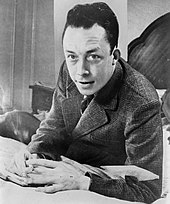
- Louis Althusser,philosopher
- Jacques Attali,economist, writer
- Paul Belmondo,sculptor, father of the actorJean-Paul Belmondo
- Patrick Bokanowski,filmmaker
- Patrick Bruel,singer
- Albert Camus,Nobel Prize-winning author and philosopher
- Claude Cohen-Tannoudji,Nobellaureate
- Étienne Daho,singer
- Jacques Derrida,philosopher
- Annie Fratellini,circus clown
- Tony Gatlif,filmmaker
- Marlène Jobert,actress and author
- Alphonse Juin,Marshal of France
- Marcel Cerdan,boxer
- Jean-François Larios,footballer
- Enrico Macias,singer
- Andrè Toubiana Varel,singer-songwriter
- Jean Pélégri,author
- Emmanuel Roblès,author
- Yves Saint Laurent,fashion designer
- Martial Solal,jazz pianist
- Joséphine Jobert,actress and singer
See also
[edit]- État pied-noir
- White Zimbabweans
- Caldoche
- Arab-Berber
- Kouloughlis
- European Moroccans
- European Tunisians
- Italian Tunisians
- Turco-Tunisians
- Italian Algerians
- Italian settlers in Libya
- French people
- White Africans of European ancestry
- White people in the Democratic Republic of the Congo
- Retornados
- List of French possessions and colonies
References
[edit]- ^De Azevedo, Raimondo Cagiano (1994)Migration and development co-operation..Council of Europe. p. 25.ISBN92-871-2611-9.
- ^Le vote pied-noir 50 ans après les accords d'EvianArchived2015-11-20 at theWayback Machine,Sciences Po,January 2012
- ^abc"pied-noir".Oxford English Dictionary, 2nd Edition.Vol. XI. Oxford, United Kingdom: Clarendon Press. 1989. pp.799.ISBN978-0-19-861223-0.
- ^abcdefgNaylor, Phillip Chiviges (2000).France and Algeria: A History of Decolonization and Transformation.University Press of Florida. pp. 9–23, 14.ISBN978-0-8130-3096-8.
- ^abcCook, Bernard A. (2001).Europe since 1945: an encyclopedia.New York: Garland. pp.398.ISBN978-0-8153-4057-7.
- ^abcGoodman, Martin; Cohen, Jeremy; Sorkin, David Jan (2005).The Oxford Handbook of Jewish Studies.Oxford:Oxford University Press.pp. 330–40.ISBN978-0-19-928032-2.
- ^abcdefg Smith, Andrea L. (2006).Colonial Memory And Postcolonial Europe: Maltese Settlers in Algeria And France.Indiana University Press. pp. 4–37, 180.ISBN978-0-253-21856-8.
- ^abc"Pieds-noirs": ceux qui ont choisi de rester,La Dépêche du Midi,March 2012
- ^abAurel etPierre Daum,«[dead link]»,Le Monde diplomatique,mai 2008, p. 16-17
- ^"'In my heart': the Europeans who remain in Algeria, 60 years on ".Retrieved2023-02-19.
- ^abcdeShepard, Todd (2006).The Invention of Decolonization: The Algerian War And the Remaking of France.Cornell University Press. pp. 213–240.ISBN978-0-8014-4360-2.
- ^"pied-noir".Dictionnaire Historique de la langue française.Vol. 2. Paris, France: Dictionnaires le Robert. March 2000. pp. 2728–9.ISBN978-2-85036-532-4.
- ^"Pieds-noirs (histoire)"[Black feet (history)].Microsoft Encarta Online(in French). 2008. Archived fromthe originalon 10 February 2009.
- ^"Francparler - Voyons en détails..."12 October 2005. Archived fromthe originalon 12 October 2005.
- ^Eric Savarese, "After the Algerian War: Reconstructing Identity among the PiedsNoirs."International Social Science Journal,58#189 (2006), pp. 457–466. doi:10.1111/j.1468-2451.2007.00644.x.
- ^abcLapidus, Ira Marvin (2002).A History of Islamic Societies.Cambridge University Press. pp. 585–600.ISBN978-0-521-77933-3.
- ^abcCountry Studies Program; formerly the Army Handbook (2006)."Country Profile: Algeria"(PDF).Library of Congress, Federal Research Division.The Library of Congress.p. 3.Retrieved2007-12-24.
- ^abMilton-Edwards, Beverley (2006).Contemporary Politics in the Middle East.Polity. pp.28.ISBN978-0-7456-3593-4.
french colonization of algeria.
- ^abcChurchill, Charles Henry (1867).The Life of Abdel Kader, Ex-sultan of the Arabs of Algeria.Chapman and Hall. pp.270.
surrender of abdel al kader.
- ^Stone, Martin (1997).The Agony of Algeria.Columbia University Press. pp.31–37.ISBN978-0-231-10911-6.
french invasion of algeria.
- ^abAmselle, Jean-Loup (2003).Affirmative exclusion: cultural pluralism and the rule of custom in France.Ithaca, N.Y.:Cornell University Press.pp.65–100.ISBN978-0-8014-8747-7.
- ^Les réformes agraires en Algérie - Lazhar Baci - Institut National Agronomique, Département d'Economie Rurale, Alger (Algérie)
- ^L'Afrique française: bulletin mensuel du Comité l'Afrique française et du Comité du Maroc, volumes 61-65,Comité du Maroc, Comité de l'Afrique française, 1957, p. 10
- ^Michel Delenclos,Les mots des uns, les maux des autres: la France et l'Algérie,Godefroy de Bouillon, 2008, p. 537.
- ^Michel de Jaeghere,Le livre blanc de l'armée française en Algérie,Contretemps, 2001, p. 47
- ^Éric Roussel,Pierre Mendès France,Paris, Gallimard, collection « NRF biographies », 2007, p. 352
- ^No. 98, juin 2002, p. 82-92
- ^Mouloud Feraoun,Les Chemins qui montent,Le Seuil, 1957, pp. 208-209.
- ^Bernard Lecherbonnier,Le pied-rouge,Denoël, 1974, p. 188
- ^François Muratet,Le Pied-Rouge,volume 13 de Serpent noir, Serpent à plumes, 1999, p. 131
- ^H. Jay Siskin,Ouvertures: cours intermédiaire de français,Harcourt College Publishers, 2001, p. 217
- ^Léon Isnard,Les trois cuisines du Maghreb: 600 recettes arabes, juives et pieds-noirs,Presses du Languedoc, Gastronomie, 2006, Montpellier, 4ede couverture.
- ^"pataouète".Rechercher: Pataouète - Dictionnaires de français Larousse.Dictionnaires de français en ligne(in French).Éditions Larousse.Archived fromthe originalon 2011-05-19.Retrieved18 October2016.
- ^Raph Soria,Autrefois, la Mékerra,BoD - Books on Demand France, 2009, Petit lexique: p. 188 à 198,ISBN2810602549.
- ^Kimmelman, Michael (5 March 2009)."Footprints of pieds-noirs reach deep into France".The New York Times.Retrieved2023-02-19.
- ^John Laurenson (29 July 2006)."Former settlers return to Algeria".BBC News.Retrieved2023-02-19.
- ^abcdefghGrenville, J. A. S. (2005).A History of the World from the 20th to the 21st Century.Routledge. pp. 520–30.ISBN978-0-415-28955-9.
- ^abcdefghiKacowicz, Arie Marcelo; Pawel Lutomski (2007).Population Resettlement in International Conflicts: A Comparative Study.Le xing ton Books. pp. 30–70.ISBN978-0-7391-1607-4.
- ^abKantowicz, Edward R. (2000).Coming apart, coming together.Grand Rapids, Mich.: W.B. Eerdmans. pp.207.ISBN978-0-8028-4456-9.
- ^Albert Habib Hourani, Malise Ruthven (2002). "A history of the Arab peoples".Harvard University Press. p.323.ISBN0-674-01017-5
- ^"ALGERIA: population growth of the whole country".Populstat.info.Archived fromthe originalon 18 July 2012.Retrieved11 January2018.
- ^"Timelines: History of Algeria".Zum.de.Retrieved11 January2018.
- ^The Agony of AlgeriaBy Martin Stone published by Columbia University Press, 1997.ISBN0231109113,page 32 (source for pieds-noir population in 1836 and 1847).
- ^"Pied-Noir".Encyclopedia of the Orient.Archived fromthe originalon 2021-01-15.Retrieved2015-07-18.
- ^abcdefStora, Benjamin (2005).Algeria, 1830-2000: A Short History.Cornell University Press.pp. 12, 77.ISBN978-0-8014-8916-7.
- ^Grobman, Alex (1983).Genocide: Critical Issues of the Holocaust.Behrman House, Inc. p. 132.ISBN978-0-940646-38-4.
- ^Stein, Sarah Abrevaya. Saharan Jews and the fate of French Algeria. University of Chicago Press, 2014.
- ^abCourrières, Yves(1968).La Guerre d'Algerie.Fayard. p. 208.ISBN978-2-213-61121-1.
- ^Bromberger, Merry and Serge (1959).Les 13 Complots du 13 Mai.Paris: Fayard.
- ^abcMeredith, Martin (27 June 2006).The Fate of Africa: A History of Fifty Years of Independence.PublicAffairs. p. 74.ISBN978-1-58648-398-2.
- ^abAlistair Horne, page 533A Savage War Of Peace,ISBN0-670-61964-7
- ^Horne, Alistair (1977).A Savage War of Peace: Algeria 1954-1962.The Viking Press. pp.533 and 537.ISBN978-0-670-61964-1.
- ^ab"French migration to South Australia (1955-1971): What Alien Registration documents can tell us".Vol. 2, Issue 2, August 2005.Flinders University Languages. Archived fromthe originalon 2008-02-28.Retrieved2007-12-25.
- ^Sempere Souvannavong, Juan David (11 January 2018)."Les pieds-noirs à Alicante".Revue Européenne de Migrations Internationales.17(3): 173–198.doi:10.3406/remi.2001.1800.hdl:10045/57388.Retrieved11 January2018.
- ^"Vidéo: l'alyah des juifs d'Algérie - JSS News - Israël - Diplomatie - Géopolitique".27 July 2010. Archived fromthe originalon 27 July 2010.
- ^Verdo, Geneviève (2002)."L'exil, la mémoire et l'intégration culturelle: les Pieds-Noirs d'Argentine, des Argentins avant la lettre?".Matériaux Pour l'Histoire de Notre Temps.67:113–118.doi:10.3406/mat.2002.402404– via Persée.
- ^"Les pieds noirs d'Argentine".Institut national de l'audiovisuel.1964.
- ^Ramsay, pp. 39-40.
- ^Alba, Richard; Silberman, Roxane (December 2002). "Decolonization Immigrations and the Social Origins of the Second Generation: The Case of North Africans in France".International Migration Review.36(4): 1169–1193.doi:10.1111/j.1747-7379.2002.tb00122.x.S2CID145811837.
- ^Dine, Philip (1994).Images of the Algerian War: French Fiction and Film, 1954-1992.Oxford University Press. pp. 189–99.ISBN978-0-19-815875-2.
- ^abcMessud, Claire (7 November 2013)."Camus & Algeria: The Moral Question".The New York Review of Books.Retrieved2018-05-26.
- ^Jean-Louis Planche,Français d'Algérie, Français en Algérie (1962-1965),in colloqueLes Accords d'Évian: en conjoncture et en longue durée,éditions René Gallissot, 1997, p. 104-105lire en ligne
- ^Hervé Mercuri (2019).Colon en Algérie 1983-1963: 4 vies, 3 guerres et 1 exil(22 cm)(récits personnels) (in French). Le Chesnay: compte d'auteur. pp. 177, 182.ISBN978-1-0996-9677-0.OCLC1135262408.BNF:457445178,SUDOC:242021638.Retrieved2022-07-17.
- ^Daniel Junqua,Le Monde,26 juin 1979, - in Pierre Laffont,Histoire de la France en Algérie,1980, p. 508.
- ^"Accueil".BLOG OFFICIEL DU GOUVERNEMENT PROVISOIRE PIED-NOIR EN EXIL.
- ^"Les Territoires".Fédération des Deux Rives, Etat Pied Noir(in French).Retrieved2022-07-20.
- ^"fotw".
- ^"fotw".
- ^"Les Africains".nice.algerianiste.free.fr.Retrieved11 January2018.
- ^John Franklin."Mémoire Vive".Magazine du C.D.H.A.No. 32, 4th trimester 2005.Retrieved2010-01-03.
Sources
[edit]- Horne, Alistair. (1977).A Savage War of Peace: Algeria, 1954-1962.Viking Press.
- McDougall, James. (2017).A History of Algeria.Cambridge University Press.
- McDougall, James. (2006).History and the culture of nationalism in Algeria.Cambridge University Press.
- Ramsay, R. (1983)The Corsican Time-Bomb,Manchester University Press: Manchester.ISBN0-7190-0893-X.
Further reading
[edit]- Eldridge, Claire; Kalter, Christoph; Taylor, Becky (2022). "Migrations of Decolonization, Welfare, and the Unevenness of Citizenship in the UK, France and Portugal".Past & Present.

![Flag proposed by Jean-Paul Gavino[67]](https://upload.wikimedia.org/wikipedia/commons/thumb/c/c4/Drapeau_des_Fran%C3%A7ais_d%27Alg%C3%A9rie.svg/180px-Drapeau_des_Fran%C3%A7ais_d%27Alg%C3%A9rie.svg.png)
![Tricolore flag with two black feet[68]](https://upload.wikimedia.org/wikipedia/commons/thumb/8/8a/Flag_of_France_%28Pieds-noirs%29.svg/180px-Flag_of_France_%28Pieds-noirs%29.svg.png)

